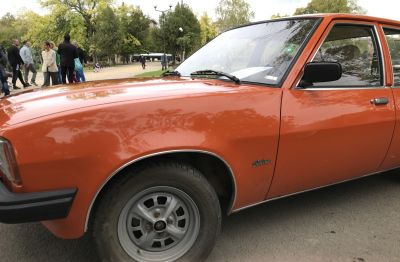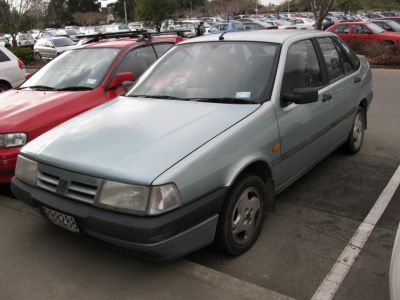 1985 Seat Malaga (023A) Dimensions, Size & Specs
1985 Seat Malaga (023A) Dimensions, Size & SpecsMeasurements of the 1985 Seat Malaga, engineered for optimal performance and comfort
| Dimensions | |
|---|---|
| Length: | 4275 mm168.3 in14.0 ft |
| Width: | 1650 mm65.0 in5.4 ft |
| Height: | 1390 mm54.7 in4.6 ft |
| Trunk Capacity: | 510 liter18.0 cu ft |
| Weight Specifications | |
| Curb Weight: | 975-1015 kg2150-2238 lbs |
| Maximal permitted Weight: | 1450 kg3197 lbs |
| Tire Specifications | |
| Tire Sizes: |
|
The Seat Malaga (023A) is a compact sedan produced by Spanish automaker Seat from 1984 to 1991. This generation of the Malaga showcases classic 1980s design and practical dimensions tailored for urban and suburban driving. The vehicle measures 4275 mm (168.3 inches) in length, 1650 mm (65.0 inches) in width, and 1390 mm (54.7 inches) in height, representing a balanced footprint ideal for maneuvering in tight city spaces while maintaining interior comfort.
The car's curb weight ranges from 975 to 1015 kg (2150 to 2237 lbs), reflecting its lightweight construction for improved fuel efficiency and handling. It supports a maximum weight of 1450 kg (3197 lbs), making it suitable for daily commuting and family use while providing stable road performance.
Luggage capacity is ample for its class, offering 510 liters (18.0 cubic feet) of trunk space, which is practical for groceries, luggage, and general cargo. The Malaga rides on tire sizes ranging from 155 SR 13, 165/70 SR 13, to 165/65 SR 14, contributing to its balanced ride comfort and handling.
Produced during the mid to late 1980s, the Seat Malaga (023A) stands as a representative example of compact sedan design during that era, combining efficient dimensions with practical interior space and competitive weight specifications. This model remains a notable choice for enthusiasts interested in classic European sedans and those seeking a historically significant compact vehicle with well-rounded proportions and utility.
Discover the standout features that make the 1985 Seat Malaga a leader in its class
Have a question? Please check our knowledgebase first.
The Seat Malaga (023A), produced from 1984 to 1991, has a length of 4275 mm (168.3 inches), a width of 1650 mm (65 inches), and a height of 1390 mm (54.7 inches). These dimensions classify it as a compact sedan, offering practical city driving usability while maintaining enough cabin space for passengers. Its moderately sized footprint makes it suitable for urban environments without compromising interior comfort.
The curb weight of the Seat Malaga (023A) ranges between 975 kg to 1015 kg (approximately 2150 to 2238 lbs), depending on specific configuration and equipment. Its maximum permissible weight, including passengers and cargo, is 1450 kg (around 3197 lbs). This weight range ensures the vehicle remains agile while providing adequate structural stability and handling characteristics expected from a sedan of this class.
The Seat Malaga (023A) offers a luggage capacity of 510 liters (about 18 cubic feet), which was quite competitive for compact sedans manufactured in the 1980s. This volume allows for a reasonable amount of storage space for daily use, including grocery trips or small luggage loads for weekend drives. Compared to contemporaries, its boot space was generous, reflecting the car’s practical design focus.
Yes, the Seat Malaga (023A), with a length of 4275 mm (168.3 inches), width of 1650 mm (65 inches), and height of 1390 mm (54.7 inches), comfortably fits into most standard garages. A typical single-car garage measures about 6 meters (236 inches) in length and 3 meters (118 inches) in width, leaving ample space around the vehicle for opening doors and maneuvering safely inside the garage.
The Seat Malaga (023A) followed the design language of its predecessor but featured noticeable dimensional improvements aimed at enhancing passenger comfort and cargo capacity. While the earlier model was shorter and slightly narrower, the Malaga's increase in length to 4275 mm (168.3 inches) and width of 1650 mm (65 inches) allowed for better interior legroom and a more spacious luggage compartment, reflecting the evolving expectations for compact sedans during the mid-1980s.
The Seat Malaga (023A) was generally on par with other compact sedans in the mid-1980s, such as the Volkswagen Jetta and Ford Escort. Its length of 4275 mm (168.3 inches) and width of 1650 mm (65 inches) offered a slightly longer body than some competitors, contributing to more spacious interiors. Its cargo volume of 510 liters (18 cubic feet) was competitive, often surpassing rivals, making it a practical choice for buyers seeking a balance of size and usability.
The Seat Malaga (023A) was equipped with tire sizes including 155 SR 13, 165/70 SR13, and 165/65 SR14, depending on the trim and production year. These relatively narrow tires, typical for compact sedans of the era, contributed to a comfortable ride and better fuel economy but offered moderate road grip. The slightly varied sizes provided options for either improved ride comfort or marginally enhanced road handling characteristics.
With a height of 1390 mm (54.7 inches) and a width of 1650 mm (65 inches), the Seat Malaga (023A) maintained a low center of gravity, which helped in improving handling stability, especially during cornering. Despite its relatively low height, the cabin was designed efficiently to maximize headroom for passengers, thus providing a comfortable seating position for front and rear occupants without sacrificing the vehicle's aerodynamic profile.
The curb weight range of 975 to 1015 kg (2150 to 2238 lbs) places the Seat Malaga (023A) among the lighter compact sedans of its time. This relatively low weight positively impacts fuel efficiency, allowing the vehicle to achieve better mileage with less engine effort. Moreover, a lighter car tends to offer more nimble handling characteristics, responsive acceleration, and easier maneuverability, especially appreciated in urban and suburban driving contexts.
The Seat Malaga (023A) is a four-door sedan, a body style that was popular in the 1980s for balancing passenger comfort with practicality. The sedan form allowed for clear separation of passenger and cargo areas, appealing to families and daily commuters alike. This classic body style also contributed to the Malaga's market success as it combined traditional aesthetics with functional usability, making it a preferred choice among compact car buyers.
Discover similar sized cars.

| Model Year: | 1979 |
|---|---|
| Length: | 4321 mm170.1 in |
| Width: | 1670 mm65.7 in |
| Height: | 1380 mm54.3 in |

| Model Year: | 1976 |
|---|---|
| Length: | 4321 mm170.1 in |
| Width: | 1670 mm65.7 in |
| Height: | 1380 mm54.3 in |

| Production: | 2011-2015 |
|---|---|
| Model Year: | 2011 |
| Length: | 4370 mm172.0 in |
| Width: | 1700 mm66.9 in |
| Height: | 1470 mm57.9 in |

| Production: | 1990-2001 |
|---|---|
| Model Year: | 1990 |
| Length: | 4355 mm171.5 in |
| Width: | 1695 mm66.7 in |
| Height: | 1445 mm56.9 in |

| Production: | 1976-1978 |
|---|---|
| Model Year: | 1976 |
| Length: | 4245 mm167.1 in |
| Width: | 1600 mm63.0 in |
| Height: | 1360 mm53.5 in |

| Production: | 1990-1996 |
|---|---|
| Model Year: | 1990 |
| Length: | 4354 mm171.4 in |
| Width: | 1695 mm66.7 in |
| Height: | 1445 mm56.9 in |

| Production: | 1998-2005 |
|---|---|
| Model Year: | 1999 |
| Length: | 4362-4369 mm171.7-172.0 in |
| Width: | 1702 mm67.0 in |
| Height: | 1430-1481 mm56.3-58.3 in |

| Production: | 1987-1991 |
|---|---|
| Model Year: | 1987 |
| Length: | 4325 mm170.3 in |
| Width: | 1641-1660 mm64.6-65.4 in |
| Height: | 1360-1400 mm53.5-55.1 in |
